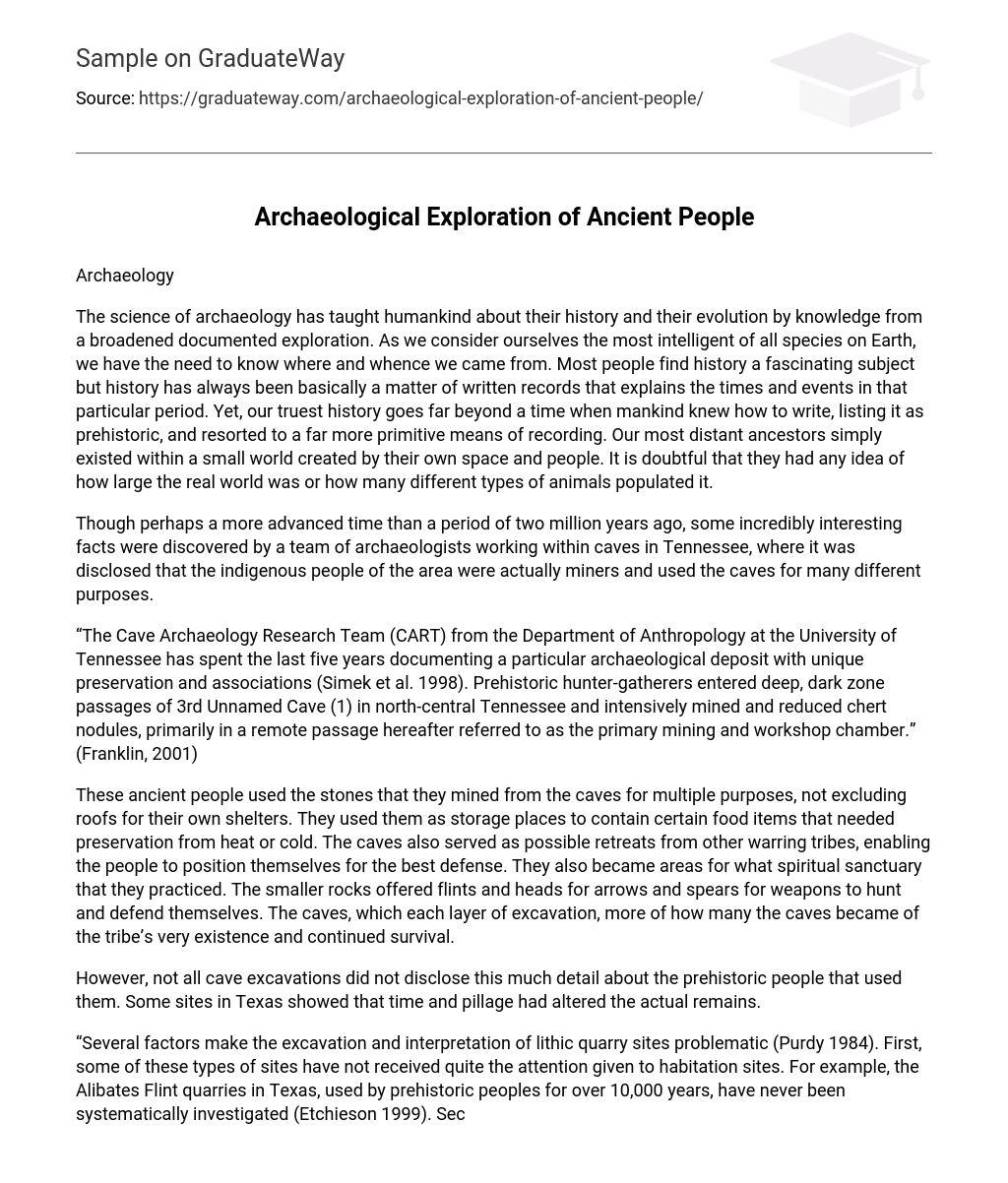Archaeology
The science of archaeology has taught humankind about their history and their evolution by knowledge from a broadened documented exploration. As we consider ourselves the most intelligent of all species on Earth, we have the need to know where and whence we came from. Most people find history a fascinating subject but history has always been basically a matter of written records that explains the times and events in that particular period. Yet, our truest history goes far beyond a time when mankind knew how to write, listing it as prehistoric, and resorted to a far more primitive means of recording. Our most distant ancestors simply existed within a small world created by their own space and people. It is doubtful that they had any idea of how large the real world was or how many different types of animals populated it.
Though perhaps a more advanced time than a period of two million years ago, some incredibly interesting facts were discovered by a team of archaeologists working within caves in Tennessee, where it was disclosed that the indigenous people of the area were actually miners and used the caves for many different purposes.
“The Cave Archaeology Research Team (CART) from the Department of Anthropology at the University of Tennessee has spent the last five years documenting a particular archaeological deposit with unique preservation and associations (Simek et al. 1998). Prehistoric hunter-gatherers entered deep, dark zone passages of 3rd Unnamed Cave (1) in north-central Tennessee and intensively mined and reduced chert nodules, primarily in a remote passage hereafter referred to as the primary mining and workshop chamber.” (Franklin, 2001)
These ancient people used the stones that they mined from the caves for multiple purposes, not excluding roofs for their own shelters. They used them as storage places to contain certain food items that needed preservation from heat or cold. The caves also served as possible retreats from other warring tribes, enabling the people to position themselves for the best defense. They also became areas for what spiritual sanctuary that they practiced. The smaller rocks offered flints and heads for arrows and spears for weapons to hunt and defend themselves. The caves, which each layer of excavation, more of how many the caves became of the tribe’s very existence and continued survival.
However, not all cave excavations did not disclose this much detail about the prehistoric people that used them. Some sites in Texas showed that time and pillage had altered the actual remains.
“Several factors make the excavation and interpretation of lithic quarry sites problematic (Purdy 1984). First, some of these types of sites have not received quite the attention given to habitation sites. For example, the Alibates Flint quarries in Texas, used by prehistoric peoples for over 10,000 years, have never been systematically investigated (Etchieson 1999). Second, there is often little stratigraphic control at prehistoric quarry sites”. (Franklin, 2001)
This first part has been discussed to address the term of “caveman”. It is an often loosely used and unsubstantiated term that would imply that our prehistoric ancestors all lived in caves. This is not a fact as it has been discovered that there were people who lived by water, people who dwelt in plains, people who populated thick jungle forests, as well as areas that were so flat as to not contain mountains or hills that could provide caves.
Time has proven that many of the processes used by people of the past have still lasting effects on us. We have learned from many of our predecessor’s mistakes and the devastating affect their actions had upon them in order to ensure that we did not repeat the mistakes. With pollution and global warming being great concerns world wide in today’s society, we have all studied the horrors that raw sewage, unsanitary conditions, barbaric medical practices, and mass squalor that made people of centuries ago ill and often beset with deadly plagues, but perhaps one of the least known facts is a case where an area of huge pollutants and chemical waste has poisoned a place to an incredible level even now, two thousand years later. Such was one of the archaeological sites of the ancient Romans as explained in this following quote.
“One of the Roman industrial revolution’s greatest production complexes–Jordan’s Wadi Faynan, 120 kilometres north of the modern Red Sea port of Aqaba–is now being investigated by scientists from the universities of Leicester, Nottingham and Aberystwyth, who are determined to discover what impact industrial pollution had on the Roman world. Their work, along with parallel research by other scientists, suggests that hundreds of thousands, perhaps millions, of people living in Europe and the Middle East between the first century BC and the second century AD were blighted, or had their lives cut short, by high levels of pollution and contamination that sometimes surpassed those of the 19th-century Industrial Revolution.” (Keys, 2003)
We can see through various case studies, that all of humankind from first conception to modern times, has used their intelligence to survive, formed opinions that created civilization, and also upon occasion, showed flagrant abuse of the planet that was their home. Though evolution has wrought great changes to our species, we are still very much a species of our own human nature.
References
Franklin, J. D. (2001). Excavating and Analyzing Prehistoric Lithic Quarries: An Example from 3rd Unnamed Cave, Tennessee. Midcontinental Journal of Archaeology, 26(2), 199+
Keys, D. (2003, December). How Rome Polluted the World: We Tend to Think of Industrial Pollution as a Modern Phenomenon but, as David Keys Reveals, the Ancient Romans Were Already Contaminating the Air, Land and Sea with Toxic Metals Two Millennia Ago. Geographical, 75, 45+.





